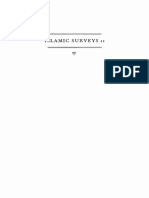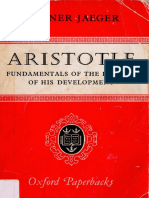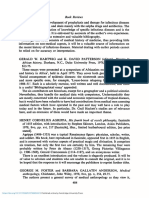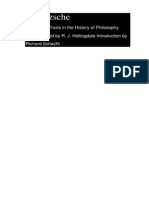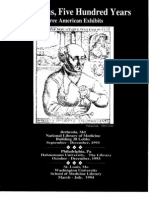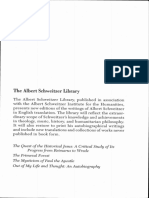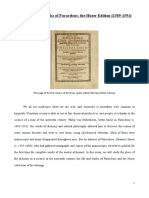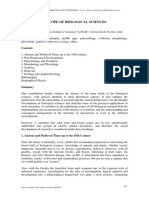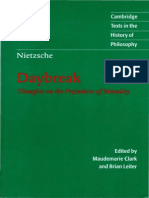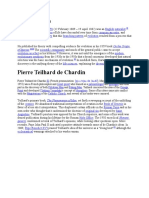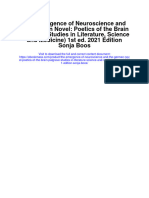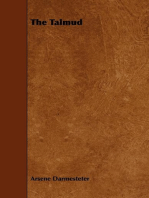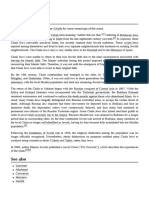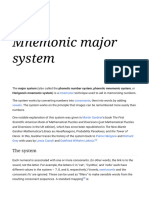Abraham - Ibn - Ezra Sefer Hanisyonot
Abraham - Ibn - Ezra Sefer Hanisyonot
Uploaded by
Mustafa ErcümenCopyright:
Available Formats
Abraham - Ibn - Ezra Sefer Hanisyonot
Abraham - Ibn - Ezra Sefer Hanisyonot
Uploaded by
Mustafa ErcümenOriginal Title
Copyright
Available Formats
Share this document
Did you find this document useful?
Is this content inappropriate?
Copyright:
Available Formats
Abraham - Ibn - Ezra Sefer Hanisyonot
Abraham - Ibn - Ezra Sefer Hanisyonot
Uploaded by
Mustafa ErcümenCopyright:
Available Formats
Book Reviews
Rae's numerous quarrels with the naval establishment, with members of the Royal
Geographical Society, with Lady Franklin, and with the British public through the press are
related without interpretation. This is a biography without personalities, and can be
recommended only for its bibliography and as a reference book for students of Arctic
exploration.
The book is attractively produced, a tribute to the workmanship of a small specialist press.
Elizabeth Haigh
Wellcome Unit for the History of Medicine, Oxford
KARL E. ROTHSCHUH, Naturheilbewegung, Reformbewegung, Alternativebewegung,
Stuttgart, Hippokrates Verlag, 1983, 8vo, pp. 148, illus., DM.58.00.
This closely (sometimes microscopically) printed work is intended as popularization.
Whatever its faults and risks, it can be placed first on the reading-lists of anyone seeking an
initial framework for research into the movements and "great" names of medical and
semi-medical heresies within German-speaking countries during the last 200 years or so.
The author, a veteran of medical historiography, is clearly unhappy at having to compress so
much into 140 pages. His discussion begins with Rousseau, to whom he attributes most of the
subsequent movements in Germany. His excursions into two millennia of European
civilization prior to Rousseau force him into potted histories which are at best old-fashioned.
Both before and after Jean-Jacques, the main method is to identify how various writers (all too
appropriately, their names are italicized) transmitted a tradition. Any popular currents are
mentioned only fleetingly, except when one of the italicized immortals is lowly-born. And
dimensions both social and political are seldom tackled, except as part of the background to
the real thing.
This procedure is particularly disquieting, given the author's plausible argument that
present-day "alternative" movements are fundamentally similar to those he is tracing. For, by
the decades around 1900, his often uncommented listing of beliefs and of men (very
occasionally their wives, sisters, or models) begins to include racism and anti-semitism. This,
one presumes, is hardly the author's fault but surely has something to do with the compression
and conventionality of his work. In particular, to mention the Third Reich merely for having
swallowed or crushed these movements (p.126) is somewhat one-sided-given, for example,
that the "architect and artist" Paul Schultze-Naumburg was allied not merely with reformers
of life-style (in particular, of female dress: p.121) but also with the likes of Julius Streicher.
Rothschuh is seeking to link pre- with post-1930s movements. But in his haste, he may
encourage a revival of the political ambiguities in the movements he narrates.
Logie Barrow
University of Bremen
J. 0. LEIBOWITZ and S. MARCUS (editors), Sefer Hanisyonot. The book of medical
experiences attributed to Abraham ibn Ezra, Jerusalem, Magnes Press, Hebrew University,
1984, 8vo, pp. 345, illus., $28.00.
The publication for the first time of Sefer Hanisyonot. The book of medical experiences,
edited, translated, and commented upon by two eminent scholars, has not only rescued the
work from oblivion but also the name of the great Arabic medical author 'Abd al-Rahman b.
al-Haitham, of whom we know little. The sub-title of the book, Medical theory. Rational and
magical therapy. A study in medievalism is appropriate, for it brings before the reader the
whole spectrum of medieval medicine and its application. This twelfth-century medical
treatise attributed to Abraham ibn Ezra and based on an earlier treatise of al-Haitham, no
longer existing in its original Arabic, is an example of the synthesis of Islamic with Jewish
culture which gave rise to the scientific and literary fame of the medieval Jewish-Arabic world.
The work begins with an introduction and evaluation of the philosophical basis of the first
456
Book Reviews
part of the treatise, which as a whole comprises nine parts devoted entirely to therapeutics.
This is followed by a review of the historical sources and useful short biographical sections
relating to Ibn Ezra and al-Haitham. The content of each part of the treatise, excluding the first
which has already been dealt with, is described with reference to other medical writers. The
psychological and symbolic significance of the remedies is discussed and the theories
commented on in the light of modern scientific knowledge. An index to this fascinating
elucidation of the text is given on pp. 339 ff.
The problem of comparing the extant Hebrew manuscripts is dealt with in the section
preceding the translation and commentary of the Hebrew text. Nine manuscripts are described
and the distinction between the books of Nisyonot of Ibn Ezra and Segulot of Ibn al-Haitham
made. The difficult task of exploring the relationship between the manuscripts, noting their
similarities and differences, is clearly set out and the apparatus employed shows with
admirable clarity the many variants between the texts by means of a novel graphical method.
The work concludes with four plates of manuscripts consulted, a useful bibliography, and the
index already referred to.
The editors have every reason to be proud of the technical skill and erudition their work
displays, and the Wellcome Trust can be well satisfied in having supported the publication of a
considerable achievement of scholarship.
Nigel Allan
Wellcome Institute
IAIN PATTISON, The British veterinary profession, 1791-1948, London, J.A. Allen, 1983,
8vo, pp. x, 207, illus., £9.50.
A comprehensive history of the British veterinary profession would be a most welcome
publication to many readers, especially those interested in the emergence of occupational
hierarchies and a profession's role within society. The modern veterinary surgeon is a splendid
example of upward social mnobility, his status before the eighteenth century similar to that of
other skilled craftsmen, but strikingly improved from the 1790s with increased professional
awareness and higher educational requirements. lain Pattison's survey begins in 1791 with the
establishment of the London Veterinary College, under the direction of Vial de St Bel, whose
early death from glanders made possible the appointment of a surgeon, Edward Coleman, as
Professor. The choice was made by a prestigious "Medical Experimental Committee", which
included John Hunter, George Baker, and William Fordyce. Throughout the book, Pattison
deals harshly with Coleman, referring to his friends, such as Astley Cooper, as "cronies" and
condemning him for earning some £3,500 a year from pupils' fees and army consultancies,
commonplace sources of income for senior surgeons in the early nineteenth century.
The emergence of veterinary journals was clearly of importance in consolidating the
profession, and Pattison relies heavily on four such journals, only one of which is earlier than
1875. An interesting range of other publications from the early nineteenth century is ignored,
such as the short-lived Veterinary Examiner, which first appeared on 1 December 1832,
seeking to facilitate "the Studies of the Veterinary Pupil" by publishing the lectures of such
eminent teachers as Coleman, Dick, and Youatt. The protracted negotiations to secure a
Royal Charter for the London College in 1844 provide an impressive tale of spite and
obstruction. As in several other instances, Pattison cannot refrain from exclaiming at the
wonder of it all, noting Thomas Walton Mayer's efforts in this field as "without telegraph,
telephone, typewriter, carbon paper or internal combustion engine", just as he cannot avoid
such homespun philosophizing as "animals never imagine they are ill" or referring to Aleen
Cust, the first female to qualify, as a "veterinary lady". Pattison rightly observes that "the vital
role of The Veterinarian in the early days of the British veterinary profession ... cannot be
over-emphasised", but it is nevertheless unacceptable to take its views, news items, and
personalities as the whole of the profession.
The 1865-6 outbreak of cattle plague deservedly receives the author's attention as "the
beginning of a Government veterinary service in Britain", but he considers the epidemic can
457
You might also like
- Debus, English ParacelsiansDocument118 pagesDebus, English ParacelsiansPrabhasvara100% (3)
- Ullmann 1997 - Islamic MedicineDocument158 pagesUllmann 1997 - Islamic MedicineSergey Minov100% (1)
- Raymond Klibansky, Erwin Panofsky, Fritz Saxl - Saturn and Melancholy: Studies in The History of Natural Philosophy, Religion and Art, 1979Document268 pagesRaymond Klibansky, Erwin Panofsky, Fritz Saxl - Saturn and Melancholy: Studies in The History of Natural Philosophy, Religion and Art, 1979Zeleny100% (4)
- Werner Jaeger - Aristotle. Fundamentals in The History of His Development-Oxford University Press (1934) PDFDocument491 pagesWerner Jaeger - Aristotle. Fundamentals in The History of His Development-Oxford University Press (1934) PDFX-I-X100% (3)
- Anaesthesia - Essays On Its History-SpringeDocument422 pagesAnaesthesia - Essays On Its History-SpringeRaluca Goicea100% (1)
- George M Foster and Barbara Gallatin Anderson Medical Anthropology Chichester John Wiley 1978 8vo PP X 354 Pound975Document2 pagesGeorge M Foster and Barbara Gallatin Anderson Medical Anthropology Chichester John Wiley 1978 8vo PP X 354 Pound975Hilal farooqNo ratings yet
- Anatomy in Alexandria in The Third Century B.C.Document35 pagesAnatomy in Alexandria in The Third Century B.C.Ricardo Branco JuliãoNo ratings yet
- BookDocument409 pagesBookTejaVu22No ratings yet
- Saturn & Melancholy - Parte1Document70 pagesSaturn & Melancholy - Parte1luca1234567No ratings yet
- Basque Witchcraft and The Spanish InquisitionDocument2 pagesBasque Witchcraft and The Spanish Inquisitionagarratecatalina0% (1)
- Anaesthesia On Its History: EssaysDocument21 pagesAnaesthesia On Its History: Essaysasta lavistaNo ratings yet
- Paracelsus and The Medical Revolution of The Renaissance R20071010ADocument18 pagesParacelsus and The Medical Revolution of The Renaissance R20071010Akvirgil100% (1)
- 4.AlbertSchweitzer OutOfMyLifeThought AnAutobiographyDocument294 pages4.AlbertSchweitzer OutOfMyLifeThought AnAutobiographyIoan CretaNo ratings yet
- Paracelsus TelepnefDocument31 pagesParacelsus TelepnefSHANMUGAPRIYANNo ratings yet
- Book Review of Science and Spectacle in The European EnlightenmentDocument3 pagesBook Review of Science and Spectacle in The European EnlightenmentJean-François Gauvin100% (2)
- Monica H Green Medical Books 2018Document27 pagesMonica H Green Medical Books 2018George SalibaNo ratings yet
- Friedrich Nietzsche - Human All Too Human A Book For Free Spirits (1996)Document430 pagesFriedrich Nietzsche - Human All Too Human A Book For Free Spirits (1996)Nigel Parkinson100% (7)
- A Biographical Dictionary of Freethinkers of All Ages and NationsFrom EverandA Biographical Dictionary of Freethinkers of All Ages and NationsNo ratings yet
- Nietzsche - Human, All Too HumanDocument433 pagesNietzsche - Human, All Too Humanplath_236546100% (4)
- RESENHA - 2009 - A Lycanthropy Reader - Werewolves in WesteDocument3 pagesRESENHA - 2009 - A Lycanthropy Reader - Werewolves in WesteUgo MaiaNo ratings yet
- Stoddart-Life of ParacelsusDocument352 pagesStoddart-Life of Paracelsusvoarchadumicus100% (2)
- Paracelso - The Complete Works PDFDocument8 pagesParacelso - The Complete Works PDFluis.incraNo ratings yet
- The Languages of Psyche: Mind and Body in Enlightenment ThoughtFrom EverandThe Languages of Psyche: Mind and Body in Enlightenment ThoughtNo ratings yet
- Upld From The Previous Century. Philosophy 1970sDocument7 pagesUpld From The Previous Century. Philosophy 1970sAlexShearNo ratings yet
- The Treatise of Irenæus of Lugdunum Against The Heresies.Document158 pagesThe Treatise of Irenæus of Lugdunum Against The Heresies.Rebekah Randall100% (4)
- The Austrian Mind: An Intellectual and Social History, 1848-1938From EverandThe Austrian Mind: An Intellectual and Social History, 1848-1938No ratings yet
- H. G. J. Moseley: The Life and Letters of an English Physicist, 1887-1915From EverandH. G. J. Moseley: The Life and Letters of an English Physicist, 1887-1915No ratings yet
- Reviews of Books: Benjamin L. BenfordDocument4 pagesReviews of Books: Benjamin L. Benfordashakow8849No ratings yet
- Reviews of Books: Benjamin L. BenfordDocument4 pagesReviews of Books: Benjamin L. Benfordashakow8849No ratings yet
- Evans-Galen The Physician As PhysiognomistDocument13 pagesEvans-Galen The Physician As Physiognomistmesato1998No ratings yet
- History of Philosophy - From Thales To The Present Time, Vol. 1Document512 pagesHistory of Philosophy - From Thales To The Present Time, Vol. 1Nelson Carvalho Neto100% (3)
- History of Science WritingDocument4 pagesHistory of Science WritingrumahbianglalaNo ratings yet
- Natural MedicinesDocument41 pagesNatural Medicinessujithsnair100% (2)
- The Doctor in LiteratureDocument20 pagesThe Doctor in Literatureamm1101No ratings yet
- Pathology and PhilatelyDocument15 pagesPathology and PhilatelyjcprollaNo ratings yet
- Book Reviews: EHR, Cxxiv. 509 (Aug. 2009)Document2 pagesBook Reviews: EHR, Cxxiv. 509 (Aug. 2009)robin_gui94No ratings yet
- History and Scope of Biological Sciences: Alberto M. SimonettaDocument9 pagesHistory and Scope of Biological Sciences: Alberto M. Simonettawhowinner69No ratings yet
- Agricola Paracelsus and ChymiaDocument9 pagesAgricola Paracelsus and ChymiashoulaNo ratings yet
- BF 01099441Document18 pagesBF 01099441metodoiset2025No ratings yet
- Friedrich Nietzsche-Daybreak - Thoughts On The Prejudices of Morality (Clearscan) - Cambridge University Press (1997) PDFDocument293 pagesFriedrich Nietzsche-Daybreak - Thoughts On The Prejudices of Morality (Clearscan) - Cambridge University Press (1997) PDFJuan Antonio Burgos100% (6)
- Nala and Damayanti, and Other PoemsDocument176 pagesNala and Damayanti, and Other Poemsnarasimma8313No ratings yet
- A Biographical Dictionary of Freethinkers of All Ages and NationsFrom EverandA Biographical Dictionary of Freethinkers of All Ages and NationsNo ratings yet
- Ambroise Paré - Historical-Gleanings-1962Document3 pagesAmbroise Paré - Historical-Gleanings-1962orlandom61No ratings yet
- A Biographical Dictionary of Freethinkers of All Ages and NationsDocument512 pagesA Biographical Dictionary of Freethinkers of All Ages and Nationsbrunitarocchi0% (1)
- Pierre Teilhard de Chardin: Charles DarwinDocument4 pagesPierre Teilhard de Chardin: Charles DarwinMimi QueyquepNo ratings yet
- Secdocument 880Document68 pagesSecdocument 880amanda.berger455No ratings yet
- Aszmann 2000Document6 pagesAszmann 2000earth chainNo ratings yet
- ԧԱԫԾԯԪԸՀԯԳԧԯԱԫԾԯԪԪԿԱԲԪԴԺՀԭԴԫԜԫԾԲԧԱԫԾԯԪԸՀԯԳԱՀԧԪԸՀ ԪԸԧԾԯԿբԪԪԿաբԪԧԨԲԯԼԯԪ%Lnxuhl+D Lwlp7Kh) Luvw) Uxlwv Ri+Dvndodk$Q$Qqrwdwhg,Qgh (Wr%Lnxuhl+D Lwlp Wkh+Heuhz-Rxuqdoriwkh+Dvndodklq*DolflduhylhzDocument5 pagesԧԱԫԾԯԪԸՀԯԳԧԯԱԫԾԯԪԪԿԱԲԪԴԺՀԭԴԫԜԫԾԲԧԱԫԾԯԪԸՀԯԳԱՀԧԪԸՀ ԪԸԧԾԯԿբԪԪԿաբԪԧԨԲԯԼԯԪ%Lnxuhl+D Lwlp7Kh) Luvw) Uxlwv Ri+Dvndodk$Q$Qqrwdwhg,Qgh (Wr%Lnxuhl+D Lwlp Wkh+Heuhz-Rxuqdoriwkh+Dvndodklq*DolflduhylhzAna CicadaNo ratings yet
- Myth and (mis)information: Constructing the medical professions in eighteenth- and nineteenth-century English literature and cultureFrom EverandMyth and (mis)information: Constructing the medical professions in eighteenth- and nineteenth-century English literature and cultureNo ratings yet
- Johann F. Blumenbach - The Anthropological Treatises of Johann F. Blumenbach-The Anthropological Society (1865)Document468 pagesJohann F. Blumenbach - The Anthropological Treatises of Johann F. Blumenbach-The Anthropological Society (1865)Max ClNo ratings yet
- Dragging Heavy: Asa To CrossDocument2 pagesDragging Heavy: Asa To CrossSemihKoyuncuNo ratings yet
- Beacon Lights of History, Volume 14 The New Era; A Supplementary Volume, by Recent Writers, as Set Forth in the Preface and Table of ContentsFrom EverandBeacon Lights of History, Volume 14 The New Era; A Supplementary Volume, by Recent Writers, as Set Forth in the Preface and Table of ContentsNo ratings yet
- Leyser - Concepts of Medieval EuropeDocument24 pagesLeyser - Concepts of Medieval EuropeAnca Pop100% (1)
- Reseña Sobre William OslerDocument3 pagesReseña Sobre William OslerroucmendNo ratings yet
- Cryle 2008 Building A Sexological Concept Through Fictional Narrative The Case of Frigidity in Late Nineteenth CenturyDocument26 pagesCryle 2008 Building A Sexological Concept Through Fictional Narrative The Case of Frigidity in Late Nineteenth CenturySam Fernández GarridoNo ratings yet
- Actor Node Positioning in Wireless Sensor NetworksDocument92 pagesActor Node Positioning in Wireless Sensor NetworksMustafa ErcümenNo ratings yet
- IJEAS0912002Document10 pagesIJEAS0912002Mustafa ErcümenNo ratings yet
- Al Kashis Miftah Al Hisab Volume II Geometry Translation and Commentary 1st Ed 9783030613297 9783030613303 CompressDocument200 pagesAl Kashis Miftah Al Hisab Volume II Geometry Translation and Commentary 1st Ed 9783030613297 9783030613303 CompressMustafa ErcümenNo ratings yet
- Moses Ibn Tibbon's Hebrew TranslationDocument26 pagesMoses Ibn Tibbon's Hebrew TranslationMustafa ErcümenNo ratings yet
- Once Upon A TImeDocument198 pagesOnce Upon A TImeMustafa ErcümenNo ratings yet
- Naca0015 Based On - Airplane Stebility Analysis Using AVLDocument9 pagesNaca0015 Based On - Airplane Stebility Analysis Using AVLMustafa ErcümenNo ratings yet
- Chala (Jews)Document2 pagesChala (Jews)Mustafa ErcümenNo ratings yet
- Ku Aka - WikipediaDocument11 pagesKu Aka - WikipediaMustafa ErcümenNo ratings yet
- Mnemonic Major System - WikipediaDocument15 pagesMnemonic Major System - WikipediaMustafa ErcümenNo ratings yet
- Neutron Production in Uranium FermiDocument5 pagesNeutron Production in Uranium FermiMustafa ErcümenNo ratings yet
- Moses Ibn GikatillaDocument2 pagesMoses Ibn GikatillaMustafa ErcümenNo ratings yet
- mth-150 Textbook Homework Briggs 3rd Ed AllDocument1 pagemth-150 Textbook Homework Briggs 3rd Ed AllMustafa ErcümenNo ratings yet
- PYTHON Lab (21CSL46) Manual 4th Sem FinalDocument69 pagesPYTHON Lab (21CSL46) Manual 4th Sem FinalShreya RangacharNo ratings yet
- Lesson Plan in PSTMDocument9 pagesLesson Plan in PSTMMichael Peralta MahinayNo ratings yet
- Elvira O. Pillo Practical Research - Maed - FilipinoDocument20 pagesElvira O. Pillo Practical Research - Maed - FilipinoAR IvleNo ratings yet
- Teaching Practice Ii ProgramDocument4 pagesTeaching Practice Ii ProgramSilvia MolinaNo ratings yet
- A Position Paper Can Be Arranged in The Following FormatDocument4 pagesA Position Paper Can Be Arranged in The Following FormatRenz EscobarteNo ratings yet
- Chamilo Admin Guide 1.9 enDocument127 pagesChamilo Admin Guide 1.9 enNatherson SouzaNo ratings yet
- Easy Way To Import User Account From AD To Oracle EBS Using Command LineDocument3 pagesEasy Way To Import User Account From AD To Oracle EBS Using Command Lineramnath.makelifesmarterNo ratings yet
- Lauren Reflection LetterDocument2 pagesLauren Reflection Letterapi-25239541350% (2)
- Good Thesis Statement For Informative SpeechDocument8 pagesGood Thesis Statement For Informative Speechogjbvqvcf100% (1)
- Sorting Noun (Person, Thing Etc)Document2 pagesSorting Noun (Person, Thing Etc)Ronnel MarcelinoNo ratings yet
- Kadiza Final Project 1Document49 pagesKadiza Final Project 1Khadiza ShakilaNo ratings yet
- 03 - PlantPAx Alarm Configuration For View 6Document16 pages03 - PlantPAx Alarm Configuration For View 6Md MicroNo ratings yet
- Walk Through The Bible #12 - Infancy Narrative, Virgin & Virgin BirthDocument45 pagesWalk Through The Bible #12 - Infancy Narrative, Virgin & Virgin BirthounbblNo ratings yet
- 21st Century LiteratureDocument7 pages21st Century LiteratureJhoanne GliponeoNo ratings yet
- TOPIK 2 Narrative Tense Past Simple & Past Continous, Past Simpe & Past Perfect, Past Perfect Continous.Document6 pagesTOPIK 2 Narrative Tense Past Simple & Past Continous, Past Simpe & Past Perfect, Past Perfect Continous.Dzaky TodayNo ratings yet
- Manual Plant Simulation Parte 2Document30 pagesManual Plant Simulation Parte 2jaciel barajasNo ratings yet
- Project Guidelines EED22303 DR ALI JULY 2023Document3 pagesProject Guidelines EED22303 DR ALI JULY 2023Danish DGNo ratings yet
- A2 Studentbook Unit 6Document6 pagesA2 Studentbook Unit 6paultrasoliniNo ratings yet
- Geh 6862Document1,010 pagesGeh 6862alaa fadhelNo ratings yet
- Windows Administration CommandsDocument5 pagesWindows Administration CommandskrsnagnaniNo ratings yet
- Destiny - Patron - Getting Started With The Patron Import ConverterDocument26 pagesDestiny - Patron - Getting Started With The Patron Import ConvertergkcampNo ratings yet
- Ajax Toolkit BlogDocument15 pagesAjax Toolkit Blogemraan khanNo ratings yet
- What Is InternetDocument2 pagesWhat Is InternetsureshexecutiveNo ratings yet
- AP Computer Science: Lesson 3 Boolean Math and LogicDocument13 pagesAP Computer Science: Lesson 3 Boolean Math and LogicMark HillikerNo ratings yet
- English ArticeDocument7 pagesEnglish ArticeAJ EdadesNo ratings yet
- Prayer Against Demonic PadlockDocument2 pagesPrayer Against Demonic PadlockmultenplanintegratedltdNo ratings yet
- MORPHEMES and ALLOMORPHSDocument15 pagesMORPHEMES and ALLOMORPHSSir PogiNo ratings yet
- Compiler DesignDocument23 pagesCompiler DesignNikodimos EndeshawNo ratings yet
- Men Who Played Important Roles QuestionsDocument2 pagesMen Who Played Important Roles QuestionsPrincess Jovie BitangaNo ratings yet
- SampleDocument4 pagesSampleinduNo ratings yet

